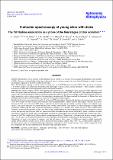Files in this item
X-shooter spectroscopy of young stars with disks : the TW Hydrae association as a probe of the final stages of disk accretion
Item metadata
| dc.contributor.author | Venuti, L. | |
| dc.contributor.author | Stelzer, B. | |
| dc.contributor.author | Alcalá, J. M. | |
| dc.contributor.author | Manara, C. F. | |
| dc.contributor.author | Frasca, A. | |
| dc.contributor.author | Jayawardhana, R. | |
| dc.contributor.author | Antoniucci, S. | |
| dc.contributor.author | Argiroffi, C. | |
| dc.contributor.author | Natta, A. | |
| dc.contributor.author | Nisini, B. | |
| dc.contributor.author | Randich, S. | |
| dc.contributor.author | Scholz, A. | |
| dc.date.accessioned | 2020-01-07T11:30:09Z | |
| dc.date.available | 2020-01-07T11:30:09Z | |
| dc.date.issued | 2019-12 | |
| dc.identifier | 265377944 | |
| dc.identifier | 28c1d414-7b64-4f49-8262-21f017f8f65b | |
| dc.identifier | 85075832012 | |
| dc.identifier | 000515114300002 | |
| dc.identifier.citation | Venuti , L , Stelzer , B , Alcalá , J M , Manara , C F , Frasca , A , Jayawardhana , R , Antoniucci , S , Argiroffi , C , Natta , A , Nisini , B , Randich , S & Scholz , A 2019 , ' X-shooter spectroscopy of young stars with disks : the TW Hydrae association as a probe of the final stages of disk accretion ' , Astronomy and Astrophysics , vol. 632 , A46 . https://doi.org/10.1051/0004-6361/201935745 | en |
| dc.identifier.issn | 0004-6361 | |
| dc.identifier.uri | https://hdl.handle.net/10023/19239 | |
| dc.description.abstract | Context. Measurements of the fraction of disk-bearing stars in clusters as a function of age indicate protoplanetary disk lifetimes ≤ 10 Myr. However, our knowledge of the time evolution of mass accretion in young stars over the disk lifespans is subject to many uncertainties, especially at the lowest stellar masses (M∗). Aims. We investigate ongoing accretion activity in young stars in the TW Hydrae association (TWA). The age of the association (∼8-10 Myr) renders it an ideal target for probing the final stages of disk accretion, and its proximity (∼50 pc) enables a detailed assessment of stellar and accretion properties down to brown dwarf masses. Methods. Our sample comprises eleven TWA members with infrared excess, amounting to 85% of the total TWA population with disks. Our targets span spectral types between M0 and M9, and masses between 0.58 M⊙ and 0.02 M⊙. We employed homogeneous spectroscopic data from 300 nm to 2500 nm, obtained synoptically with the X-shooter spectrograph, to derive the individual extinction, stellar parameters, and accretion parameters for each object simultaneously. We then examined the luminosity of Balmer lines and forbidden emission lines to probe the physics of the star-disk interaction environment.Results. Disk-bearing stars represent around 24% of the total TWA population. We detected signatures of ongoing accretion for 70% of our TWA targets for which accurate measurements of the stellar parameters could be derived. This implies a fraction of accretors between 13-17% across the entire TWA (that accounts for the disk-bearing and potentially accreting members not included in our survey). The spectral emission associated with these stars reveals a more evolved stage of these accretors compared to younger PMS populations studied with the same instrument and analysis techniques (e.g., Lupus): first, a large fraction (∼50%) exhibit nearly symmetric, narrow Hα line profiles; second, over 80% of them exhibit Balmer decrements that are consistent with moderate accretion activity and optically thin emission; third, less than a third exhibit forbidden line emission in [O I] 6300 Å, which is indicative of winds and outflows activity; and fourth, only one sixth exhibit signatures of collimated jets. However, the distribution in accretion rates (M acc) derived for the TWA sample closely follows that of younger regions (Lupus, Chamaeleon I, σ Orionis) over the mass range of overlap (M∗ ∼ 0.1-0.3 M⊙). An overall correlation between M acc and M∗ is detected and best reproduced by the function M acc ∝ M∝2.1±0.5.Conclusion. At least in the lowest M∗ regimes, stars that still retain a disk at ages ∼8-10 Myr are found to exhibit statistically similar, albeit moderate, accretion levels as those measured around younger objects. This "slow" M acc evolution that is apparent at the lowest masses may be associated with longer evolutionary timescales of disks around low-mass stars, which is suggested by the mass-dependent disk fractions reported in the literature within individual clusters. | |
| dc.format.extent | 26 | |
| dc.format.extent | 3646446 | |
| dc.language.iso | eng | |
| dc.relation.ispartof | Astronomy and Astrophysics | en |
| dc.subject | Accretion | en |
| dc.subject | Accretion disks | en |
| dc.subject | Techniques: spectroscopic | en |
| dc.subject | Stars: low-mass | en |
| dc.subject | Stars: pre-main sequence | en |
| dc.subject | Open clusters and associations: individual: TWA | en |
| dc.subject | QB Astronomy | en |
| dc.subject | QC Physics | en |
| dc.subject | Space and Planetary Science | en |
| dc.subject | Astronomy and Astrophysics | en |
| dc.subject | DAS | en |
| dc.subject.lcc | QB | en |
| dc.subject.lcc | QC | en |
| dc.title | X-shooter spectroscopy of young stars with disks : the TW Hydrae association as a probe of the final stages of disk accretion | en |
| dc.type | Journal article | en |
| dc.contributor.institution | University of St Andrews. School of Physics and Astronomy | en |
| dc.contributor.institution | University of St Andrews. St Andrews Centre for Exoplanet Science | en |
| dc.identifier.doi | https://doi.org/10.1051/0004-6361/201935745 | |
| dc.description.status | Peer reviewed | en |
| dc.identifier.url | https://arxiv.org/abs/1909.06699 | en |
This item appears in the following Collection(s)
Items in the St Andrews Research Repository are protected by copyright, with all rights reserved, unless otherwise indicated.

